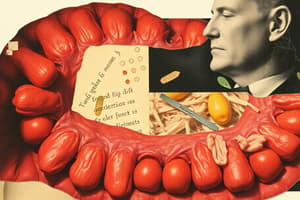Podcast
Questions and Answers
What role does enterokinase play in protein digestion?
What role does enterokinase play in protein digestion?
Enterokinase converts the inactive enzyme trypsinogen into the active enzyme trypsin.
How does bile aid in lipid digestion?
How does bile aid in lipid digestion?
Bile emulsifies large fat globules into smaller droplets, facilitating the action of lipases.
Describe the function of pancreatic amylase in carbohydrate digestion.
Describe the function of pancreatic amylase in carbohydrate digestion.
Pancreatic amylase continues the digestion of carbohydrates by breaking them down into disaccharides.
What distinguishes trypsin from pepsin in protein digestion?
What distinguishes trypsin from pepsin in protein digestion?
What is the final outcome of protein digestion in the small intestine?
What is the final outcome of protein digestion in the small intestine?
What role does saliva play in the process of digestion?
What role does saliva play in the process of digestion?
How do taste buds function in the perception of flavors?
How do taste buds function in the perception of flavors?
What are the different types of teeth and their primary functions?
What are the different types of teeth and their primary functions?
Describe the process of peristalsis in the esophagus.
Describe the process of peristalsis in the esophagus.
What is the function of the sphincters in the stomach?
What is the function of the sphincters in the stomach?
Why is the pH level of the stomach so low, and what are its effects?
Why is the pH level of the stomach so low, and what are its effects?
What components make up gastric fluid, and what are their functions?
What components make up gastric fluid, and what are their functions?
What adaptations do the walls of the stomach have to accommodate food storage?
What adaptations do the walls of the stomach have to accommodate food storage?
Flashcards
Trypsin
Trypsin
An enzyme produced by the pancreas that breaks down long polypeptide chains into shorter peptides during protein digestion.
Erepsins
Erepsins
A group of enzymes released by the pancreas and small intestine that complete protein digestion by breaking down short-chain peptides into individual amino acids.
Pancreatic Amylase
Pancreatic Amylase
An enzyme produced by the pancreas that continues the digestion of carbohydrates, breaking down intermediate-sized carbohydrates into disaccharides.
Bile
Bile
Signup and view all the flashcards
Lipases
Lipases
Signup and view all the flashcards
Physical Digestion
Physical Digestion
Signup and view all the flashcards
Amylase
Amylase
Signup and view all the flashcards
Stomach
Stomach
Signup and view all the flashcards
Hydrochloric Acid (HCl)
Hydrochloric Acid (HCl)
Signup and view all the flashcards
Mucous
Mucous
Signup and view all the flashcards
Smooth Muscle
Smooth Muscle
Signup and view all the flashcards
Study Notes
Mouth
- Physical digestion begins in the mouth.
- Food is chewed and formed into a bolus by the tongue.
- Saliva contains amylase enzymes that initiate carbohydrate breakdown.
- Saliva lubricates food passage, dissolves food particles, and activates taste buds.
Taste
- Food particles dissolve, penetrating taste bud cells on the tongue and cheeks.
- Different receptors respond to specific tastes (flavors).
- Taste buds have receptors with specific shapes.
- Nerve cells for taste respond when receptor sites bind to complementary shaped chemical compounds.
Teeth
- Teeth are important for physical digestion.
- Incisors are for cutting.
- Canines are for tearing.
- Premolars are for grinding.
- Molars are for crushing food, located next to premolars.
Esophagus
- The bolus stretches the esophagus.
- Smooth muscles create rhythmic contractions called peristalsis.
- Peristalsis moves food along the gastrointestinal tract (involuntarily).
Stomach
- Food storage and initial protein digestion occur in the stomach.
- Sphincters regulate food entry and exit from the stomach.
- Cardiac sphincter closes the opening near the heart, allowing food to enter.
- Pyloric sphincter regulates the movement to the small intestine.
- The J-shaped stomach has rugae that allows expansion, storing about 1.5 liters.
- Millions of stomach lining cells secrete gastric fluids (juices).
Gastric Fluids
- Gastric fluids include mucous, hydrochloric acid (HCl), pepsinogen, and others.
- Mucous provides a protective coating.
- Hydrochloric acid keeps the pH between 2.0 and 3.0 (can approach 1.0), killing ingested harmful substances.
- Hydrochloric acid converts pepsinogen to pepsin (protein-digesting enzyme).
- Pepsin breaks long amino acid protein chains into shorter chains (polypeptides).
Protein Digestion
- Trypsinogen (enzyme released by pancreas) is converted into trypsin in the small intestine.
- Trypsin breaks down polypeptides into shorter peptides.
- Erepsins (from the pancreas and small intestine) complete protein digestion, breaking peptides into individual amino acids.
Carbohydrate Digestion
- Pancreatic amylase continues carbohydrate digestion begun in the mouth by salivary amylase.
- Intermediate carbohydrates are broken into disaccharides.
- Disaccharidases (enzymes from the small intestine) complete carbohydrate digestion.
Lipid Digestion
- The liver produces bile with bile salts to aid fat digestion.
- Bile is stored and concentrated in the gall bladder.
- Bile salts emulsify large fat globules.
- Lipases (pancreatic enzymes) break down fats into fatty acids and glycerol.
- Phospholipase acts on phospholipids.
Studying That Suits You
Use AI to generate personalized quizzes and flashcards to suit your learning preferences.




